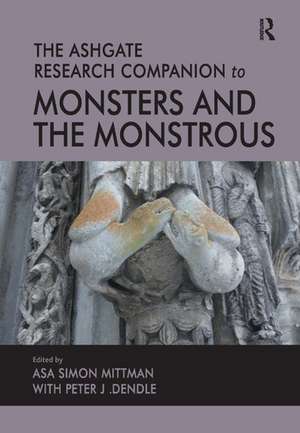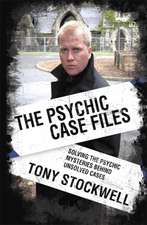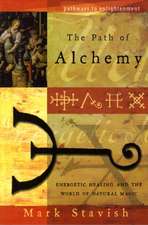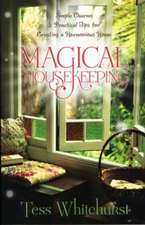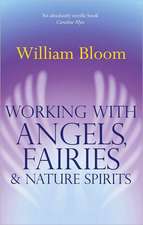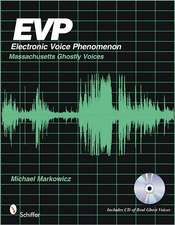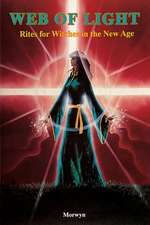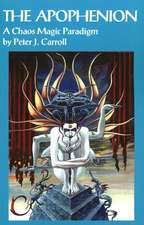The Ashgate Research Companion to Monsters and the Monstrous
Editat de Asa Simon Mittman, Peter J. Dendleen Limba Engleză Paperback – 15 aug 2013
Preț: 451.04 lei
Preț vechi: 490.26 lei
-8% Nou
Puncte Express: 677
Preț estimativ în valută:
86.31€ • 89.57$ • 72.15£
86.31€ • 89.57$ • 72.15£
Carte tipărită la comandă
Livrare economică 17-31 martie
Preluare comenzi: 021 569.72.76
Specificații
ISBN-13: 9781472418012
ISBN-10: 1472418018
Pagini: 600
Ilustrații: Includes 71 b&w illustrations
Dimensiuni: 169 x 244 x 35 mm
Greutate: 0.98 kg
Ediția:New ed
Editura: Taylor & Francis
Colecția Routledge
Locul publicării:Oxford, United Kingdom
ISBN-10: 1472418018
Pagini: 600
Ilustrații: Includes 71 b&w illustrations
Dimensiuni: 169 x 244 x 35 mm
Greutate: 0.98 kg
Ediția:New ed
Editura: Taylor & Francis
Colecția Routledge
Locul publicării:Oxford, United Kingdom
Cuprins
Contents: Foreword, John Block Friedman; Introduction: the impact of monsters and monster studies, Asa Simon Mittman; Part I History of Monstrosity: The monstrous Caribbean, Persephone Braham; The unlucky, the bad and the ugly: categories of monstrosity from the Renaissance to the Enlightenment, Surekha Davies; Beauteous beast: the water deity Mami Wata in Africa, Henry John Drewal; Rejecting and embracing the monstrous in Ancient Greece and Rome, D. Felton; Early modern past to postmodern future: changing discourses of Japanese monsters, Michael Dylan Foster; On the monstrous in the Islamic visual tradition, Francesca Leoni; Human of the heart: pitiful oni in medieval Japan, Michelle Osterfield Li; The Maya 'cosmic monster' as a political and religious symbol, Matthew Looper; Monsters lift the veil: Chinese animal hybrids and processes of transformation, Karin Myhre; From hideous to hedonist: the changing face of the 19th-century monster, Abigail Lee Six and Hannah Thompson; Centaurs, satyrs, and cynocephali: medieval scholarly teratology and the question of the human, Karl Steel; Invisible monsters: vision, horror, and contemporary culture, Jeffrey Andrew Weinstock. Part II Critical Approaches to Monstrosity: Posthuman teratology, Patricia MacCormack; Monstrous sexuality: variations on the vagina dentata, Sarah Alison Miller; Postcolonial monsters: a conversation with Partha Mitter, Partha Mitter with Asa Simon Mittman and Peter Dendle; Monstrous gender: geographies of ambiguity, Dana Oswald; Monstrosity and race in the late Middle Ages, Debra Higgs Strickland; Hic sunt dracones: the geography and cartography of monsters, Chet van Duzer; Conclusion: monsters in the 21st century: the preternatural in an age of scientific consensus, Peter J. Dendle; Postscript: the promise of monsters, Jeffrey Jerome Cohen; Bibliography; Index.
Notă biografică
Asa Simon Mittman is Associate Professor, Department of Art and Art History, California State University, Chico, USA and Peter Dendle is Associate Professor, Department of English, Pennsylvania State University, Mont Alto, USA.
Recenzii
"This thought-provoking volume provides a fascinating overview of monsters in a variety of social and academic contexts… Useful for undergraduate and graduate seminars and as a resource for advanced scholars… Highly recommended. All academic levels/libraries." --Choice
'This volume awakens the monster as an academic topic. Combining John Block Friedman's historical-literary approach with Jeffrey J. Cohen's theoretical concerns, Asa Simon Mittman and Peter Dendle have marshalled chapters that comprise a seminal work for everyone interested in the monstrous. Wide-ranging chapters work through various historical and geographic views of monstrosity, from the African Mami Wata to Pokemon. Theoretical chapters consider contemporary views of what a monster is and why we care about them as we do. Taken together, the essays in The Ashgate Research Companion to Monsters and the Monstrous reveal that monsters appear in every culture and haunt each of us in different ways, or as Mittman says, the monstrous 'calls into question our (their, anyone's) epistemological worldview, highlights its fragmentary and inadequate nature, and thereby asks us […] to acknowledge the failures of our systems of categorization.'' --David Sprunger, Concordia College, Minnesota, USA
"An impressively broad and thoughtful collection of the ways in which many cultures, ancient and modern, have used monsters to think about what it means to be human. Lavishly illustrated and ambitious in scope, this book enlarges the reader's imagination." --Professor Lorraine Daston, Director of the Max Planck Institute for the History of Science, Germany
"This is a huge work… Not surely for the paws and pelts cryptozoologist, but of value to anyone with a serious interest in the monsters of the human imagination." --Magonia Review of Books
"… a work of considerable erudition and scholarship, suitably footnoted and indexed. Ranging over art history, religious studies, literature, classics, history, anthropology and cultural studies, The Ashgate Companion reflects the truly multi-disciplinary nature of the topic… it will become an essential academic reference source for the ''monstrous''." --Sydney Morning Herald
"This is a multidisciplinary volume illustrating the richness and diversity of monster studies as a discipline. The contributors of this volume are widely disparate in theoretical and scholarly background, allowing for a rich and diverse reading of the monstrous subject… They illustrate that there is not one monolithic theory of the monstrous but that, much like the monstrous figures it examines, monstrosity theory is widely disparate, theoretically diverse, and represents a hybridisation of multiple genres." --Lo Sguardo
"Throughout, the essays refer to and expand on themes and ideas discussed elsewhere. By the end of the collection what we are faced with is an excellent example of the research in progress within the field of monster studies, in depth enough and with sufficient variety to appeal to monster scholars yet equally accessible to the newcomer to the field." --Kelvingrove Review
"The Ashgate Research Companion to Monsters and the Monstrous is a ground-breaking guide to unreal creatures - the contested modern “real” sciences of cryptozoology and ufology are largely excluded here - from historical, regional and thematic perspectives. Edited by an associate professor of art history and of English respectively and with contributions from 21 other academics in North America and the UK, this volume is a substantial and truly cross-disciplinary enterprise, embracing history, classics and religious, cultural and media studies in addition to literature and art." --Reference Reviews
'This volume awakens the monster as an academic topic. Combining John Block Friedman's historical-literary approach with Jeffrey J. Cohen's theoretical concerns, Asa Simon Mittman and Peter Dendle have marshalled chapters that comprise a seminal work for everyone interested in the monstrous. Wide-ranging chapters work through various historical and geographic views of monstrosity, from the African Mami Wata to Pokemon. Theoretical chapters consider contemporary views of what a monster is and why we care about them as we do. Taken together, the essays in The Ashgate Research Companion to Monsters and the Monstrous reveal that monsters appear in every culture and haunt each of us in different ways, or as Mittman says, the monstrous 'calls into question our (their, anyone's) epistemological worldview, highlights its fragmentary and inadequate nature, and thereby asks us […] to acknowledge the failures of our systems of categorization.'' --David Sprunger, Concordia College, Minnesota, USA
"An impressively broad and thoughtful collection of the ways in which many cultures, ancient and modern, have used monsters to think about what it means to be human. Lavishly illustrated and ambitious in scope, this book enlarges the reader's imagination." --Professor Lorraine Daston, Director of the Max Planck Institute for the History of Science, Germany
"This is a huge work… Not surely for the paws and pelts cryptozoologist, but of value to anyone with a serious interest in the monsters of the human imagination." --Magonia Review of Books
"… a work of considerable erudition and scholarship, suitably footnoted and indexed. Ranging over art history, religious studies, literature, classics, history, anthropology and cultural studies, The Ashgate Companion reflects the truly multi-disciplinary nature of the topic… it will become an essential academic reference source for the ''monstrous''." --Sydney Morning Herald
"This is a multidisciplinary volume illustrating the richness and diversity of monster studies as a discipline. The contributors of this volume are widely disparate in theoretical and scholarly background, allowing for a rich and diverse reading of the monstrous subject… They illustrate that there is not one monolithic theory of the monstrous but that, much like the monstrous figures it examines, monstrosity theory is widely disparate, theoretically diverse, and represents a hybridisation of multiple genres." --Lo Sguardo
"Throughout, the essays refer to and expand on themes and ideas discussed elsewhere. By the end of the collection what we are faced with is an excellent example of the research in progress within the field of monster studies, in depth enough and with sufficient variety to appeal to monster scholars yet equally accessible to the newcomer to the field." --Kelvingrove Review
"The Ashgate Research Companion to Monsters and the Monstrous is a ground-breaking guide to unreal creatures - the contested modern “real” sciences of cryptozoology and ufology are largely excluded here - from historical, regional and thematic perspectives. Edited by an associate professor of art history and of English respectively and with contributions from 21 other academics in North America and the UK, this volume is a substantial and truly cross-disciplinary enterprise, embracing history, classics and religious, cultural and media studies in addition to literature and art." --Reference Reviews
Descriere
The field of monster studies has grown significantly over the past few years and this companion provides a comprehensive guide to the study of monsters and the monstrous from historical, regional and thematic perspectives. The collection reflects the truly multi-disciplinary nature of monster studies, bringing in scholars from literature, art history, religious studies, history, classics and cultural and media studies. The companion offers scholars and graduate students the first comprehensive and authoritative review of this emergent field.
